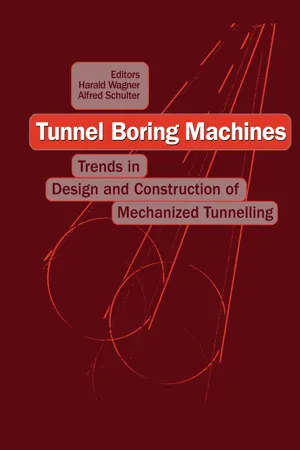ABSTRACT
In civil engineering, tunnel construction has always been based on observations far more than any other construction. Reason for this phenomenon can be seen in the fact, that there is no other condition as decisive as the changing ground conditions in underground construction. Observational methods by their nature are subject of experience, especially when using predominantly manual methods for construction. Experience can be explained as kind of data base of an individual. With the development of information technology it became feasible for almost everybody to collect data, and to work on data base. In addition to this, mechanization started to become an increasing part of underground construction. It was only a question of time when the marriage between information technology and mechanization was to be celebrated.
Parallel hereto, tunnelling became more and more subject of engineering and thus also subject of design. The designers started to develop models, and to develop simulations to model nature in their design office, and to prepare documents for projects on competitive basis. This was the time, when Geomechatronics became the logic consequence of mechanization and the capability, to combine mechanization with information technology. With steadily increasing requirements in regard to quality, safety and economy, the bell of automation and robotic systems is ringing. In accordance with the complex nature of the network consisting of mechanical and civil engineering, civil engineers and especially geotechnical engineers are challenged to develop innovative solutions. Geomechatronics will help to track along this route of interfusion successfully between civil engineers and mechanical engineers, between lining and rock and between individual lining segments.
INTRODUCING GEOMECHATRONICS
In recent years one of the leading European car manufacturers has expressed the willingness, to employ all of the graduates of the mechatronic faculty of Linz University. This shows the excellent reputation which this faculty could gain in the past. Inspired by this success, and oriented at the same industrial needs, an institute has been created in association with the Universities of Linz and Innsbruck and in close cooperation with the Industry, dedicated to the mechatronic idea. This institute has been named Geomechatronic Center Linz, (GCL). The market of underground engineering and construction is growing and to some extent related to the growth of world population. There are developments of people escaping from the country side to the urban areas mostly in the coastal regions, creating transportation needs. Solutions can only be found by going underground using concepts and systems on a competitive basis. With geomechatronics in TBM-tunnelling, the potential of improvements in regard to cost and quality has a real chance to grow.
Geomechatronic is using the disciplines of mechanics, electronics and robotics in the field of geotechnology. Geotechnology means all geotechnic technologies including especially TBM-technology. By the nature of this new discipline, there are stronger roots and relations in mechanized tunnelling, especially when entering into full face tunnel boring concepts with precast concrete segmental linings, than in conventional tunnelling with incremental support. However, in spite of some differences in the lining concept, conventional tunnelling is considered to be included in geomechatronics as well. The basics of the geomechanical understanding of the interaction between excavation and geomechanical response are considered to be identical, as it all depends on the ground.
Geomechatronic thus acts as a connecting member between geotechnology and mechatronics. It has to be based on structural assumptions allowing for the development of advanced mechatronic approach. Structural details and even construction procedures have to be developed in order to be compatible with the mechatronic approach. The use of standard features even if mixed with one or the other mechatronical suitable detail, e.g. of the lining joints, may end up in results, which do not significant differ from standard solutions.
ENGINEERING AND DESIGN
Engineering is in general a human endeavor. It is integrated into our culture and intellectual tradition. The ideas of engineering are in fact in our bones, and historically became part of our human nature. Fundamental understanding and appreciation of engineers and engineering can be achieved without any engineering training or any other technical education.
Design has to be understood in context with engineering, also when applying geomechatronics. Design is creating something, which has not existed before. Design is essential to engineering, and is virtually synonymous for any technical development. Structural design is most commonly associated with mechanical and civil engineering and with the suitability for automation.
The concept of failure in mechanical and structural engineering is essential of all engineering understanding including the geomechatronic approach. Engineering design has its first and for most objective in failure observation and subsequently prevention. Disasters that do occur are ultimately failures either of design or construction. The lessons learned from disasters can do more to advance engineering knowledge than all successful machines and structures in the world together.
Failures appear to be inevitable in the wake of prolonged success, which encourages lower margins of safety. Failures in turn lead to greater safety margins and new periods of success. To understand what engineering is, and what engineers do, is to understand how failures can happen, and how they can contribute more than successes to advance the underground technology. With t...

